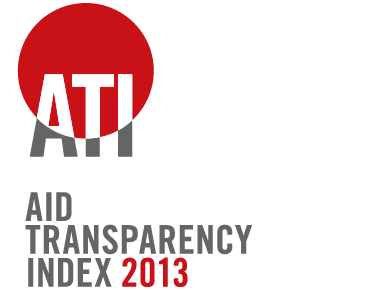Further Findings – #09.
A note on size
Back to OverviewIn the 2013 ATI, as in previous years, large* organisations generally score better than small ones. Bigger does not necessarily mean better, as donors of all sizes appearing throughout the ranking, but there are a few possible theories to explain why larger donors tend to perform better:
Practical: Larger organisations require better knowledge management systems in order to collect and share their information internally. For example, they may have more country offices and rely on many different implementers to deliver the activities for them. Having one project database that is used in all their country offices generally means that staff have to be trained to use it, are required to refer to it more regularly and it’s used at HQ for collating information so is more highly valued. These databases are often linked to the organisation’s financial management system as well. The smaller the organisation, the fewer offices it may have and the less implementers it works with, the less effort it needs to put into getting these systems in place, as the information can be shared more easily and on a more ad hoc basis as fewer people are accessing it. However, this theory doesn’t quite stand up as some large organisations appear lower down the ranking (U.S. PEPFAR, France AFD and Japan MOFA are all ranked very poor), so perhaps another reason relates to the organisation’s profile.
Profile: Larger organisations are subject to more scrutiny by:
- Their funders. Large multilaterals such as the EC and the IMF need to account to their funders on what they’re doing with the money they receive and why the funders should continue giving them money in the future. For example, assessing progress on transparency and accountability is part of the UK’s interim report for the Multilateral Aid Review – see chart 19. All the organisations were scored in 2011 when the original MAR was completed. Since then, IATI has been incorporated into the transparency and accountability criteria and the interim report gives them a progress rating. The UK has explicitly stated that performance in the MAR will be taken into consideration when deciding on which multilaterals it will fund in the future (see p.10 “We will carry out a full reassessment of value for money through a MAR in 2015, to inform future funding decisions and the reform agenda going forward”).
- Civil society. Large organisations such as the World Bank have been subject to successful advocacy campaigns by civil society focusing on access to information. Perhaps they perform better in the Index because they are further down the line on implementing transparency as they’ve been subject to more outside scrutiny and are better-known providers of aid and therefore put under more pressure.
- Self-perception. These organisations consider themselves (and indeed want to be seen) as leaders within their sector. They want to demonstrate that what they do is worthwhile, that they’re accountable and that they collaborate with others in their sector, i.e. they are less individualistic than a small donor that may be focusing on one specific region or sector and therefore engages with fewer donor organisations.
Methodology: Index data that is collected via the survey asks only at the largest recipient country, because it is simple to identify and creates a reasonable basis on which to compare between donors. We have always acknowledged that this approach cannot give a true picture of the amount of information being published at activity level. The ultimate constraint is not being able to identify all current activities being delivered to all countries or sectors. Without that information being provided in a well-structured format, it is impossible to randomly sample for an ‘average’ country and an ‘average’ project. We have therefore taken a purposive sampling approach. We recognise that this may introduce positive bias, as it seems more likely that donors will publish the most information for their largest recipient, but this was a deliberate decision. Arguably, it’s more important that funds are transparent when flows are larger. Our aim is not to try to ‘catch out’ donors. Selecting at random a smaller recipient country could introduce negative bias, and as the flows assessed would represent a much smaller proportion of the donor’s total, it would reveal less about that donor’s overall approach to aid transparency. So, perhaps large organisations perform well because we’re often looking at high-profile projects in high-risk environments such as Afghanistan, which are subject to more public scrutiny (see point 2) and require strong project and financial management systems to be in place (see point 1).
* We define large donors as those spending USD 5 billion/year in ODA, and very large donors as those spending over USD 10 bn (as reported to the DAC CRS for 2010).
